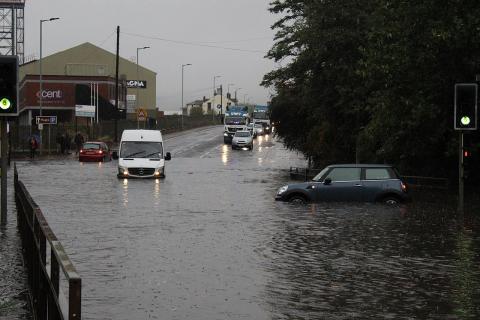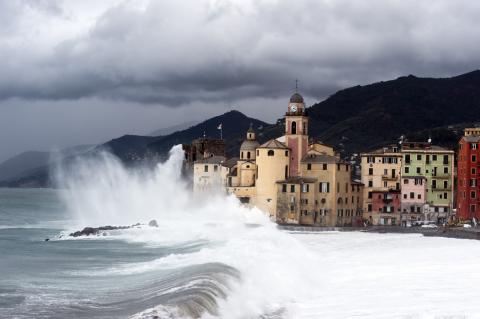Reactions to Pakistan's massive flooding episode
This summer's monsoon rains in Pakistan are ten times heavier than usual and have already affected more than 33 million people. Some six and a half million are in need of humanitarian assistance, including more than 400,000 refugees. Pakistan's prime minister has called them "the worst in the country's history".

Ernesto Rodríguez - inundaciones Pakistán EN
Ernesto Rodríguez Camino
Senior State Meteorologist and president of Spanish Meteorological Association
Monsoons are a regime of winds that alternate during the year as a function of the differential warming of the land and the ocean. As the land warms more rapidly than the ocean in response to solar radiation, this differential heating leads to a rise in land-based air masses over land, generating an ocean-land circulation similar to the sea breeze regime. While sea breezes have a daily periodicity and are restricted to a small coastal strip, monsoons have an annual periodicity and their extension is continental. Associated with the wind regime is a precipitation regime that occurs when moist marine air is forced by the wind up the continental slopes with consequent condensation of moisture and generation of precipitation. Notably, the monsoon in the Indian subcontinent combines high solar radiation - being in tropical latitudes - with the large mountain ranges that separate the Indian subcontinent from the rest of the Asian continent.
Pakistan's recent exceptional floods are the result of a strong summer monsoon which, as every year, generously waters the region during the rainy season and which this year is not immune to exceptional warming associated with heat waves in the preceding months. The anthropogenic climate change in which we are immersed is predicting an increase in rainfall over the region, which will be greater the higher the average global temperature increase that is reached. In the absence of concrete studies to attribute the causes of this individual episode, the future will bring increasingly frequent and intense episodes like the current one.
Pilar Brufau - inundaciones Pakistán EN
Pilar Brufau
Researcher and Lecturer in the Department of Materials and Fluids Science and Technology at the University of Zaragoza
Floods are natural processes that must occur from time to time in order to fertilise the land, supply reservoirs, recharge aquifers or maintain the flora and fauna of the natural ecosystem of rivers. However, in recent years, extreme flooding events have been observed around the world due to the accumulation of precipitation in a short period of time, increased frequency of precipitation or precipitous snowmelt, with catastrophic consequences, the cause of which may well be due in large part to climate change.
In order to establish this relationship, we can reflect on the temperature of the atmosphere over the last few decades, noting that it is increasing. This increase in temperature in turn leads to an increase in the temperature of the water in the seas and oceans, generating greater evaporation of water, with the consequent formation of clouds that at a given moment precipitate abruptly and intensely in a short period of time. This rainfall is naturally carried by the land towards the lower areas where the rivers are located, which are sometimes unable to transport the entire amount of water they receive through their channels, either because the flood plains have been occupied by humans (farms, buildings, etc.), or because the water flow section in the river itself has decreased due to the accumulation of gravel or sediment at the bottom, etc. For this reason, the river overflows, with changes in ground cover, such as the elimination of vegetation on some banks, being one of the causes that makes the situation worse.
Numerical models for medium-term predictions of atmospheric temperatures predict an increase in atmospheric temperatures ranging from 2.4 degrees Celsius to 5.9 degrees Celsius by 2050 if annual greenhouse gas emissions continue to increase at the current rate. For this reason, it is likely to be expected that, if air temperatures continue to rise, more extreme flood events will occur in the near future in areas already affected by such events in the past and also in new areas (flood plains or coastal areas).
Of course, Europe, and Spain in particular, are not exempt from suffering this type of extreme events, and for this reason there are flood risk management plans, which include as prevention measures the elaboration of risk maps in the most exposed areas. In addition, there are now robust, fast and accurate numerical models for predicting the movement of water in a flood event, which are well calibrated and allow the extent of the flood sheet, the time of arrival of the flood peak and the maximum height that the water will reach at certain control points to be determined in a very short time. These tools, such as the one developed by the Computational Hydraulics Group of the University of Zaragoza, are currently available to public administrations (the Ebro Hydrographic Confederation has already implemented it) and private companies that carry out flood studies. Funding is currently being sought so that citizens themselves, in a simple way, can use these same tools and thus become more aware of the risk, its consequences and how to minimise damage. Other possible measures to mitigate these extreme flood events, in a more structural way, could be: reducing greenhouse gas emissions to try to control the increase in atmospheric temperature or improving ground cover at low altitudes using reforestation and land restoration.



